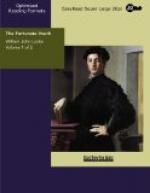Between the young man of immaculate vesture, of impeccable manners, of undeniable culture, of instinctive sympathy with the great world where great things are done, of unerring tact, of mythological beauty and charm, of boundless ambition, of resistless energy, of incalculable promise, in outer semblance and in avowed creed the fine flower of aristocratic England, professing the divine right of the House of Lords and the utilitarian sanctity of the Church of England—between Paul, that is to say, and the Radical, progressive councillor of Hickney Heath, the Free Zionist dissenter (not even Congregationalist or Baptist or Wesleyan, or any powerfully organized Non-conformist whose conscience archbishops consult with astute patronage), the purveyor of fried fish, the man of crude, uncultivated taste, there should have been a gulf fixed as wide as the Pacific Ocean. As a matter of fact, whatever gulf lay between them was narrow enough to be bridged comfortably over by mutual esteem. Paul took to visiting Mr. Finn. Accustomed to the somewhat tired or conventional creeds of his political world, he found refreshment in the man’s intense faith. He also found pathetic attraction in the man’s efforts towards self-expression. Mr. Finn, who lived a life of great loneliness—scarcely a soul, said Jane, crossed his threshold from month’s end to month’s end—seemed delighted to have a sympathetic visitor to whom he could display his painted treasures. When he was among them the haunting pain vanished from his eyes, as sometimes one has seen it vanish from those of an unhappy woman among her flowers. He loved to take Paul through his collection and point out the beauties and claim his admiration. He had converted a conservatory running along one side of the house into a picture gallery, and this was filled with his masterpieces of pictorial villainy. Here Paul was at first astonished at recognizing replicas of pictures which hung in other rooms. Mr. Finn explained.
“These,” said he, “are the originals.”
Paul pondered over the dark saying for a moment or two until he came upon a half-finished canvas on an easel. It was the copy of a landscape on the wall. He turned questioningly to his host. The latter smiled.
“I’m a bit of an artist myself,” he said. “But as I’ve never had time for lessons in painting, I teach myself by copying good pictures. It’s a Saunders”—a name unknown to Paul—“and a very good example. It’s called Noontide. The cow is particularly good, isn’t it? But it’s exceedingly difficult. That fore-shortening—I can’t get it quite right yet. But I go on and on till I succeed. The only way.”
Paul acquiesced and asked him where he had picked up his Saunders. Indeed, where had he picked up all the others? Not an exhibition in London would have admitted one of them. This “Saunders” represented a wooden cow out of drawing lying in the shade of a conventional tree. It was peculiarly bad.




